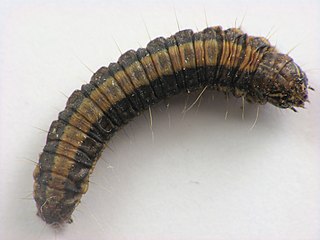
Crambinae is a large subfamily of the lepidopteran family Crambidae, the crambid snout moths. It currently includes over 1,800 species worldwide. The larvae are root feeders or stem borers, mostly on grasses. A few species are pests of sod grasses, maize, sugar cane, rice, and other Poaceae. The monophyly of this group is supported by the structure of the tympanal organs and the phallus attached medially to the juxta, as well as genetic analyses.

Cisthene is a genus of lichen moths in the family Erebidae. The genus was erected by Francis Walker in 1854.
Paracles is a genus of moths in the subfamily Arctiinae. The genus was described by Francis Walker in 1855. The species range from Panama to Patagonia, with quite a few in the southern temperate region of South America.

Talara is a genus of moths in the subfamily Arctiinae.

Anania is a genus of moths of the family Crambidae described by Jacob Hübner in 1823.

Argyria is a genus of moths of the family Crambidae. The genus was described by Jacob Hübner in 1818.

Blepharomastix is a genus of moths of the family Crambidae described by Julius Lederer in 1863.

Diatraea is a genus of moths of the family Crambidae.

Herpetogramma is a genus of moths of the family Crambidae described by Julius Lederer in 1863. It currently comprises 106 species and is found in North America, Eurasia, Australia, New Zealand, Central and South America. Of the few species where host plants are known, the larvae mostly feed on grasses.

Lineodes is a genus of snout moths of the subfamily Spilomelinae in the family Crambidae. The genus was described by Achille Guenée in 1854, with Lineodes hieroglyphalis as the type species.

Xubida is a genus of moths of the family Crambidae.

Anomis is a genus of moths in the family Erebidae.

Leptostales is a genus of moths in the family Geometridae.

Harrison Gray Dyar Jr. was an American entomologist. Dyar's Law, a pattern of geometric progression in the growth of insect parts, is named after him. He was also noted for eccentric pursuits which included digging tunnels under his home. He had a complicated personal life and along with his second wife he adopted the Baháʼí Faith.

The Chrysauginae are a subfamily of snout moths. They are primarily Neotropical and include about 400 described species.

The Epipaschiinae are a subfamily of snout moths. More than 720 species are known today, which are found mainly in the tropics and subtropics. Some occur in temperate regions, but the subfamily is apparently completely absent from Europe, at least as native species. A few Epipaschiinae are crop pests that may occasionally become economically significant.

Hylesia is a genus of moths in the family Saturniidae. The genus was erected by Jacob Hübner in 1820.

Galasa is a genus of snout moths. It was described by Francis Walker in 1866.

Zophodia is a genus of snout moths in the subfamily Phycitinae. It was erected by Jacob Hübner in 1825.
Givira is a genus of moths in the family Cossidae.

















